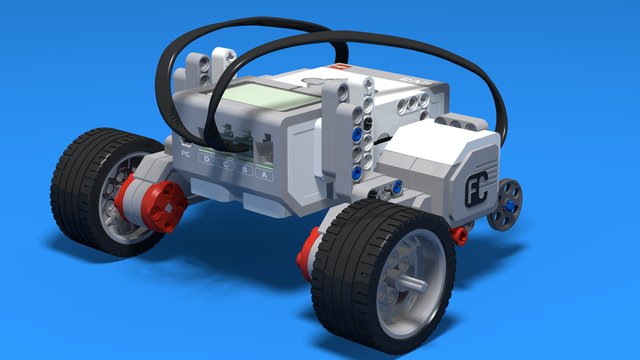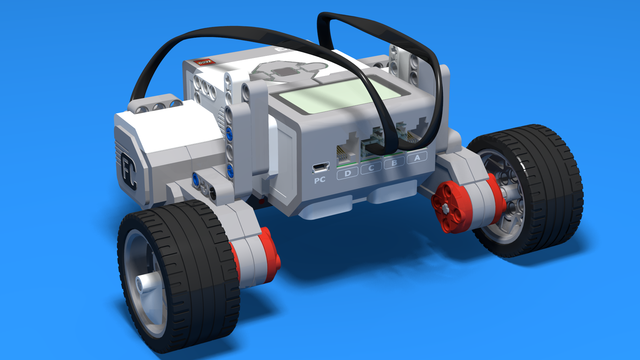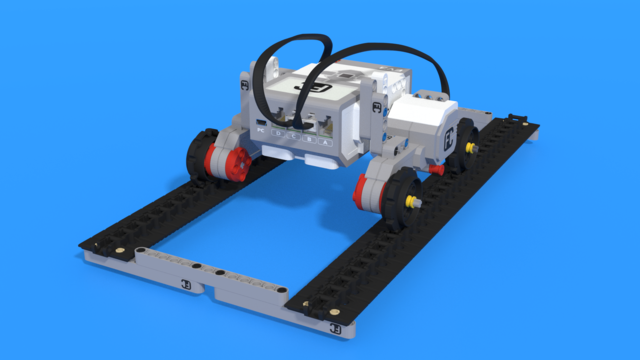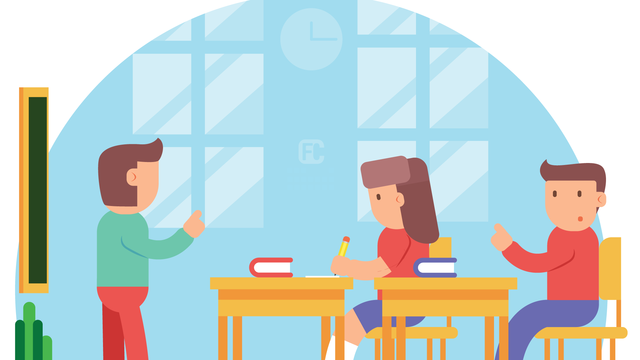A detailed description of today's main challenge: Navigating a Tunnel

To access the full video please subscribe to FLLCasts.com
- #630
- 23 Aug 2017
Known turns
A known turn means you know the sequence of the turns. You are solving a task for a tunnel with consistent 90-degree turns in the following order: right, left, right, left.
We might say you are programming a highly specialized robot. As you advance in robotics, you will learn how to navigate tunnels with unknown turns and even real labyrinths.
Unknown distance
Nevertheless, this task is not easy. You know the next turn is right, but you do not know how far it is.
Your robot should be able to handle both very short and very long tunnels using the same program.
A Tight Tunnel
It is possible that the tunnel is very tight, making it difficult for your robot to turn. Which turn should you use in this situation?
Various Types of Turns
Today, you can practice various types of turns. You already know the three types of turns with two motors and a bearing wheel. Use them accordingly.
Courses and lessons with this Tutorial
This Tutorial is used in the following courses and lessons

Level A1. Introduction. Robotics with LEGO
Introduction to robotics - The first level of the Robotics with LEGO curriculum for students in second, third or fourth grades. A journey in space, with robots. Various constructions with robots are built. Learn how to control the motors so that the robot navigates around the Sun, the Moon and Earth in various ways. Getting to know the first of the sensors. The robot can feel its surroundings with the help of the Touch sensor and avoid obstacles.
- 142
- 133:42
- 187

Lesson 7 - Navigation in a Labyrinth
For students who will not take two levels in a row today is their last lesson.
- 9
- 3
- 5
- 3d_rotation 1

Level A2. "Space exploration". Robotics with LEGO
The second level of the Robotics with LEGO curriculum for students in second, third or fourth grades.
A new sensor is introduced - the Ultrasonic distance sensor can help the robot avoid obstacles. Students work with new concepts like loop, degrees and medium motor. Robots can now do two different actions at the same time - while solving missions on a field, the third motor clears detected obstacles. The first robot with chain-treads is built.
- 63
- 3:02
- 117

Lesson 5 - Navigation in a Labyrinth
Remember to provide feedback to students regularly. It's important to give structured feedback in the form of a grade. Today, you'll need to grade your students following this article.
- 10
- 3
- 2
- 3d_rotation 1

Robotics with LEGO - Level 1.0 - Adventure in Space
The first level of the Robotics with LEGO curriculum for students in fifth to twelfth grades.
Various constructions with robots are built. Learn how to control the motors so that the robot navigates around the Moon and Earth in various ways. Getting to know the first two sensors. The robot can feel its surroundings with the help of the Touch sensor and avoid obstacles.
The Ultrasonic distance sensor can help the robot avoid obstacles. Students work with concepts like loop, degrees and medium motor. Robots can now do two different actions at the same time - while solving missions on a field, the third motor clears detected obstacles.
- 126
- 123:52
- 150

Robotics with LEGO - Level 1.0 - Adventure in Space
The first level of the Robotics with LEGO curriculum for students in fifth to twelfth grades.
Various constructions with robots are built. Learn how to control the motors so that the robot navigates around the Moon and Earth in various ways. Getting to know the first two sensors. The robot can feel its surroundings with the help of the Touch sensor and avoid obstacles.
The Ultrasonic distance sensor can help the robot avoid obstacles. Students work with concepts like loop, degrees and medium motor. Robots can now do two different actions at the same time - while solving missions on a field, the third motor clears detected obstacles.
- 126
- 123:52
- 150

Python with LEGO Mindstorms EV3 - Level 2
In the second level of Python for EV3 robots, students learn in-depth the touch sensor. The sensor is used as an input device for manual control of machines, as well as a sensor for autonomous robots. In a pair of lessons, students build a control panel for the grabber and the movement of a crane. Programming wise, students learn how to fork code with "if-else" constructions, how to create conditional and forever loops with "while" and how to negate conditions with "not" operator. In the end of the lesson, robots can detect obstacles and avoid them, so that they traverse a simple labyrinth.
- 39
- 19:58
- 93

Lesson 7 - Passing through a tunnel
For students who will not take two levels in a row today is their last lesson.
- 10
- 3
- 8
- 3d_rotation 1

Level A2 - History and Mythology - Robotics with LEGO SPIKE Prime
This is the second level of the LEGO Robotics Curriculum for second, third, and fourth-grade students.
In this level, we will focus on History and Mythology, with each lesson covering a different aspect of the ancient world. You will learn about a new distance sensor that uses ultrasound to help a watchtower robot detect invaders. We will also introduce new concepts such as loops, degrees, and a third motor. Additionally, you will learn how robots can perform two different tasks simultaneously.
- 28
- 0:00
- 65

Lesson 6 - Exploring an Egyptian pyramid
Introduction
Have you heard of the Egyptian pyramids? What do you know about them?

Near the city of Cairo, there are three pyramids. The largest of them is the Great Pyramid of Giza. It is around 4600 years old and was built during the Old Kingdom of Egypt. It is so old that historians say we live closer to the Roman Empire than the Roman Empire was to the building of the pyramids! It was used as a tomb for Pharaoh Khufu. To preserve the body of the pharaoh, the pyramid was constructed like a labyrinth to prevent anyone from finding it. To study the pyramid, our robot will need to navigate this labyrinth.
Since the pyramid is so old and full of delicate hieroglyphs, using a force sensor to navigate is not an option, as even light touches might damage the writings. That's why we will use our new sensor: the distance sensor!
- 5
- 5
- 9
- 3d_rotation 1

Level A2 - History and Mythology - Robotics with LEGO SPIKE Prime
This is the second level of the LEGO Robotics Curriculum for second, third, and fourth-grade students.
In this level, we will focus on History and Mythology, with each lesson covering a different aspect of the ancient world. You will learn about a new distance sensor that uses ultrasound to help a watchtower robot detect invaders. We will also introduce new concepts such as loops, degrees, and a third motor. Additionally, you will learn how robots can perform two different tasks simultaneously.
- 28
- 0:00
- 65

Lesson 3 - Myth of the Labrys
Introduction
Do you know what a labyrinth is?
A labyrinth is a complex, confusing structure designed to make people lose their way in its winding pathways.

The story behind the word "Labyrinth" is fascinating and is today's topic! It originates from an ancient Greek myth about the Labrys. According to legend, King Minos of Crete had a magical double-sided battleaxe called the Labrys. To protect it, he had the architect Daedalus build a massive maze and placed the Labrys at its center. This labyrinth also imprisoned a terrifying beast called the Minotaur, a half-bull, half-man creature. After defeating Athens in a war, King Minos demanded that every nine years, seven boys and seven girls be sent to be fed to the Minotaur.
Eventually, the hero Theseus, founder of Athens, traveled to Crete to slay the beast and save the children. King Minos' daughter, Ariadne, fell in love with Theseus and gave him a golden ball of thread to help him navigate the labyrinth. With this and Daedalus' help, Theseus solved the labyrinth, slew the Minotaur, retrieved the Labrys, and escaped with the children and Ariadne.
The myth has some basis in reality. Archaeologists have found remnants of a labyrinth on Crete, and many coins from the period feature an engraved labyrinth, often with a Minotaur inside. The Labrys was also a symbol of Crete and appears on numerous archaeological finds.
- 5
- 4
- 9
- 3d_rotation 1

